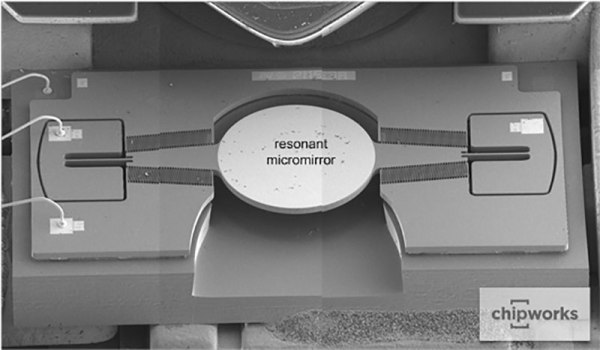[Chipworks] has just released the details on their latest teardown on an Intel RealSense gesture camera that was built into a Lenovo laptop. Teardowns are always interesting (and we suspect that [Chipworks] can’t eat breakfast without tearing it down), but this one reveals some fascinating details on how you build a projector into a module that fits into a laptop bezel. While most structured light projectors use a single, static pattern projected through a mask, this one uses a real projection mechanism to send different patterns that help the device detect gestures faster, all in a mechanism that is thinner than a poker chip.
 It does this by using an impressive miniaturized projector made of three tiny components: an IR laser, a line lens and a resonant micromirror. The line lens takes the point of light from the IR laser and turns it into a flat horizontal line. This is then bounced off the resonant micromirror, which is twisted by an electrical signal. This micromirror is moved by a torsional drive system, where an electrostatic signal twists the mirror, which is manufactured in a single piece. The system is described in more detail in this PDF of a presentation by the makers, ST Micro. This combination of lens and rapidly moving mirrors creates a pattern of light that is projected, and the reflection is detected by the IR camera on the other side of the module, which is used to create a 3D model that can be used to detect gestures, faces, and other objects. It’s a neat insight into how you can miniaturize things by approaching them in a different way.
It does this by using an impressive miniaturized projector made of three tiny components: an IR laser, a line lens and a resonant micromirror. The line lens takes the point of light from the IR laser and turns it into a flat horizontal line. This is then bounced off the resonant micromirror, which is twisted by an electrical signal. This micromirror is moved by a torsional drive system, where an electrostatic signal twists the mirror, which is manufactured in a single piece. The system is described in more detail in this PDF of a presentation by the makers, ST Micro. This combination of lens and rapidly moving mirrors creates a pattern of light that is projected, and the reflection is detected by the IR camera on the other side of the module, which is used to create a 3D model that can be used to detect gestures, faces, and other objects. It’s a neat insight into how you can miniaturize things by approaching them in a different way.












